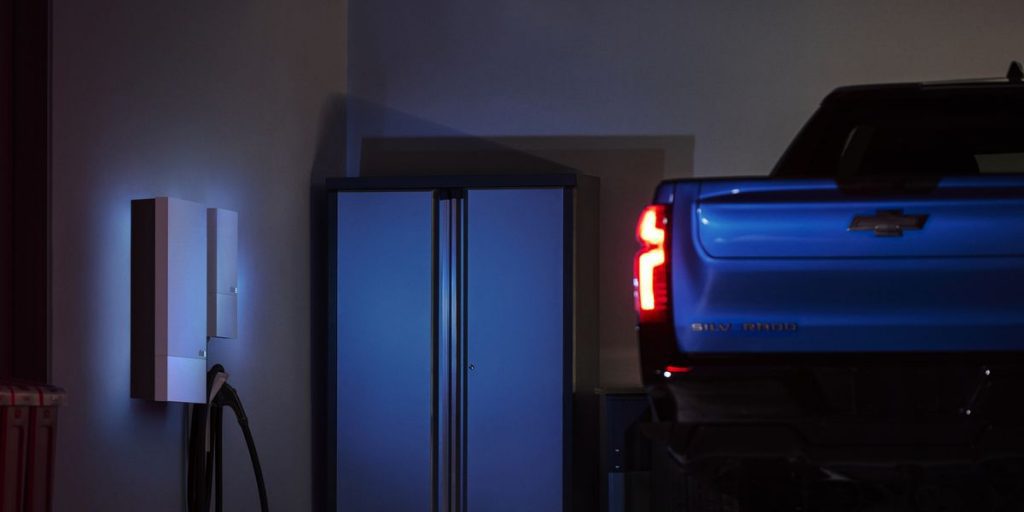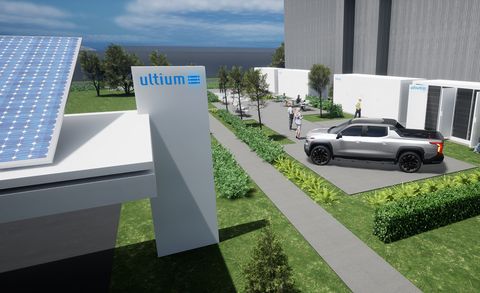GM Announces Major Jump into the Energy Business – Here's What It Will Do for EV Owners

General Motors is looking to help EV buyers leverage the energy of those big Ultium battery packs onboard—and to make some money from managing the use of the energy, too.The auto company has formed a GM Energy business unit to do just that, it announced today. It will be split into Ultium Home, Ultium Commercial, and Ultium Charge 360 divisions.
Among the targets: backup power and lowering the cost of EV ownership by letting utilities use some of your EV’s energy.
This morning, General Motors announced it has formed a new business unit called GM Energy, which will offer seamless “integrated energy management” products and services for homes and businesses to its electric-vehicle customers.
Essentially, that means GM will help owners of Ultium-based EVs lower their energy costs, use their cars for emergency backup power, and—if they agree—perhaps even lower their lease payments by letting utilities draw small amounts of energy from their EVs when plugged in.
Today’s EVs have large battery packs with capacities of 60 to 200 kilowatt-hours of energy, or two to seven times the daily usage by the average U.S. household. Road trips aside, average daily travels of 30 to 100 miles use up only half of that at most.
GM’s new unit will build a business that links the distributed energy storage of millions of EVs to owners’ homes (as backup power, replacing gasoline-fueled generators) and, more ambitiously, to the broader electric grid. GM plans to “play across the entire energy ecosystem,” in the words of Mark Bole, head of V2X and Battery Solutions, during a press preview in advance of this announcement.
GM
See Ya Later, Generator?
Last year, Ford seemed to have been caught off guard by intense public interest in an aspect of its F-150 Lightning electric pickup. That was the ability to power a home at up to 19.2 kilowatts for up to several days on a fully charged battery—at least in the top version, with modifications to home wiring.
Other EVs offer power-out capabilities, at lower rates: the latest EVs from Hyundai and Kia have conventional three-prong, 120-volt outlets at the base of the rear seat to run various consumer electronics. (Cue glossy advertisements of a silent EV parked next to a remote lake, powering a picnic-table lamp, an electric grill, a fridge, maybe even a portable stereo.) Their output of up to 6.6 kW won’t power your entire home, though it might keep your kitchen refrigerator running.
Backup power for emergencies is one of two home applications GM discussed. The other is lower electric bills from charging the EV when rates are lowest, then using some of its energy to power the house during peak demand periods, substituting for grid electricity when rates are highest.
Emergency backup power gets greater attention, though. As more frequent extreme weather events cause widespread, heavily publicized power outages, interest in simple, convenient, automatic backup for home energy will grow. Many homeowners don’t want to wrestle with a noisy gasoline-fired generator, which can’t be used indoors and produces exhaust emissions. EVs offer an alternative: Plug in the car at night and get the same backup. If there’s a grid outage, your charging station switches automatically from recharging the battery to using that battery to power your house.
GM wants to help with that. Its new unit will provide a range of Ultium Home products and services, including bidirectional wall-mounted charging stations, to let any of its new EVs based on the Ultium platform provide backup power.
Specific details of how that will work have yet to be spelled out. Its first products and services won’t go into production for a year, sometime in the fourth quarter of 2023. If successful, it’s not hard to imagine a future GM role in helping homeowners and commercial customers install solar panels or hydrogen fuel cells, set up microgrids, and participate more actively in all facets of energy generation and storage.
The Energy Storage Problem
Electric utilities today have little way to store energy. For 100-plus years, they’ve generated just enough power to meet demand, turning plant output up and down as needed. The classic form of energy storage is a dam: You can use excess generation to pump water uphill, then release it through hydroelectric turbines to return that power to the grid. But building new dams in the U.S. is now very, very difficult.

GM
Storage is more needed than ever now, for the growing percentage of renewable energy, which doesn’t always provide steady, consistent power to the grid. Solar only comes on during the day, except for . . . clouds. Wind is strongest at night, but intermittent. So utilities are experimenting with climate-controlled battery bunkers to store and buffer that intermittent generation. Not only do batteries keep the grid stable against those fluctuations, they let utilities store renewably generated energy for the highest-demand periods: those hot, muggy Friday afternoons when everyone comes back home, cranks up the A/C, and turns on lots of electronics.
To your local electric utility, your EV—and your neighbors’—represent a tantalizing pool of energy storage, with a relatively low total power draw if charged overnight, when demand is lowest. The most forward thinking of the nation’s 3500-plus electric utilities see EVs “more as a solution than as a problem to be solved,” said Travis Hester, vice president of GM EV Growth Operations.
But those utilities often don’t know where EVs are located, let alone have the ability to connect to them “bidirectionally,” to pull out (small amounts of) energy for short periods to stabilize the grid or supplement their own generation during high demand.
GM wants to help with that, too. It will know where every single Ultium vehicle is located, via the cars’ cellular connections. And it can communicate with the home stations it sells that charge them. Now the automaker is reaching out to hundreds of large utilities to start the lengthy process of negotiating deals to connect those EVs as storage resources—for which utilities will pay GM.
To say that’s a complex task would be a gross understatement. But GM sees itself as perfectly positioned to be that middleman between EV owners and their various utilities—and, importantly, to do so at scale. This applies especially to fleet buyers who operate multiple EVs, providing greater scale from a single customer—which is why GM plans a separate suite of Ultium Commercial products and services as well.
While Tesla provides battery storage products to homeowners and at utility scale, it has made no moves to connect the millions of EVs it’s sold to the grid or to act as home backup themselves.
Lower EV Lease Payments?
Individual buyers of Ultium-based EVs from Cadillac, Chevrolet, GMC, and Buick will be able to control the degree to which they allow any of these capabilities, Hester said: “They can play in as much or as little of this ecosystem as they like.”
But, he suggested, they’ll want these products and services for several reasons. First is daily energy management: using EVs to store cheap energy, then substitute it for pricier peak-period energy. Second is backup power during emergencies.
Third will be free energy management software—GM Energy Cloud—that lets homeowners look at data on when they use power and how much it costs. GM can offer advice on how to reduce overall energy spending if desired.
Finally comes cash. Utilities today incentivize and even pay customers for “managed usage.” This may be setting your washing machine to run after midnight, or letting the utility switch off your home air conditioning for 15 minutes to reduce total load.
From cheaper electric rates to actual cash bounties, demand management is worth a lot to utilities. EV owners will benefit, and GM will pass along to owners a cut of the increased load reduction and energy balancing fees their EVs enable. The same applies to fleet and commercial customers—in spades.
Hester suggested consumers might see that cash in the form of lower lease payments for Ultium EVs. Will these products and services apply to other EVs as well? Maybe, later on. But right now, it’s all about GM’s electric vehicles—1 million by 2025, it says.
This content is imported from OpenWeb. You may be able to find the same content in another format, or you may be able to find more information, at their web site.





